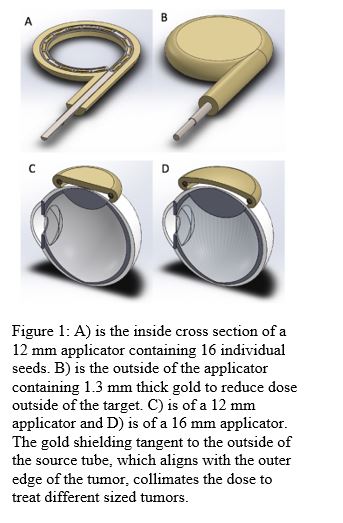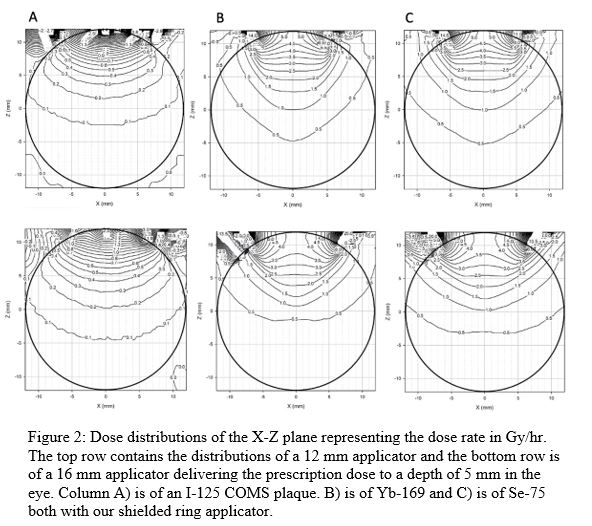Intensity modulated HDR ocular brachytherapy using Yb-169 and Se-75
OC-0027
Abstract
Intensity modulated HDR ocular brachytherapy using Yb-169 and Se-75
Authors: Justine Dupere1, John J Munro III2, David C Medich1
1Worcester Polytechnic Institute, Physics, Worcester, USA; 2Montrose Technology Inc, Physics, North Andover, USA
Show Affiliations
Hide Affiliations
Purpose or Objective
Ocular melanomas currently are treated using
brachytherapy plaques containing I-125 or Pd-103 seeds. Because the geometry of
these seeds are fixed, it is difficult to achieve an optimal dose distribution,
which contributes to a significant number of radiation associated ocular
complications. This treatment also requires two minor surgeries- the first to
suture the plaque onto the sclera and the second to remove the plaque after
5-12 days. Because of this, the surgeon receives a significant dose to the
hands of about 2-6 mSv per procedure.
We propose an alternative approach for treating
ocular melanomas by using middle energy HDR brachytherapy sources such as Yb-169
and Se-75, along with a gold shielded applicator that is designed to permit the
use of an afterloader device with a treatment time of 10 minutes. Because this
device uses middle energy photons, it is possible to modulate the dose
distributions to optimize dose to the tumor while minimizing the absorbed dose
to healthy tissues. In addition, using an afterloader will eliminate dose to
the surgeon's hands during applicator placement.
Material and Methods
The
proposed ring source is an assembly of discrete sources that are delivered
together into an applicator that forms a circular ring configuration. This
array of sources is contained in a spring-like structure, which maintains
containment and provides flexibility. The gold applicator has a conical
collimator opening, tangent to the outside of the source tube, which will act
to alter and focus the dose distribution. Figure 1 shows the design of the
applicator and the collimation. The prescribed dose rate for HDR eye plaque
brachytherapy is 3 Gy/min for 10 minutes at a depth of 5 mm. Using MCNP6, we
simulated the ring source containing Yb-169 and Se-75 with different diameter
applicators and varying collimator angles to reach various depths within the
tumor.

Results
The MCNP6 simulation results show that a
Yb-169 or Se-75 HDR source array placed in the proposed gold applicator can
reduce the absorbed dose to healthy tissue while simultaneously delivering the
prescription dose to the target. The dose to critical structures in the eye is
about 30% higher when using Se-75 compared to Yb-169 however it is still within
acceptable limits. Figure 2 shows the dose distributions of a 12 and 16 mm
applicator delivering the prescription dose to a 5 mm depth in the eye for Yb-169
and Se-75 compared to an I-125 COMS plaque. Simulations were also performed
using different collimators to deliver the dose to 3.5-8.0 mm depths in the eye
to cover tumors 10-15 mm in diameter.

Conclusion
A novel
eye plaque design is proposed using middle energy HDR brachytherapy sources
with gold shielding. This source assembly is able to deliver a dose of 3 Gy/min
to a depth of 5 mm in the eye in 10 minutes. More conformal dose distributions
can be achieved from the conical opening and gold shielding. This design also
permits the use of an automated afterloader, which eliminates dose to the
surgeon’s hands.